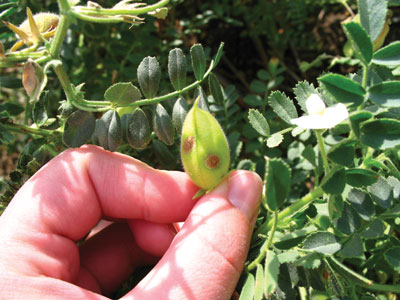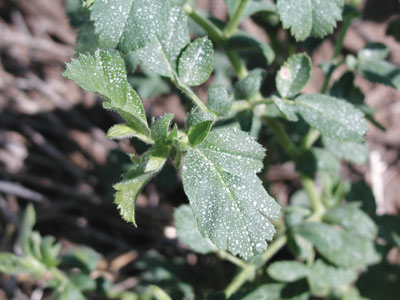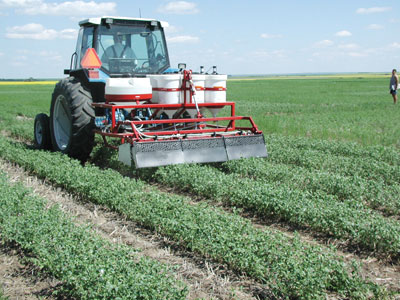
Features
Fungicides
Seed & Chemical
Controlling ascochyta blight in chickpeas
Ascochyta blight is a fungal disease that infects chickpeas and farmers’ bank accounts alike.
November 17, 2011 By Lisa Guenther
Ascochyta blight is a fungal disease that infects chickpeas and farmers’ bank accounts alike. It is one factor that has limited chickpea production in Saskatchewan, and, if left unchecked, can wipe out 70 percent or more of a chickpea crop.
 |
|
|
Ascochyta blight on chickpea. |
Ascochyta spores can infest a crop through infected seed or straw from last year’s chickpea crop. Wind carries spores from neighbouring fields, and rain splash transfers spores from infected plants to nearby healthy ones. The spores are persistent, surviving in soil for up to four years. However, if producers manage the disease carefully, they can reduce infection levels in their crops. Choosing the right variety is an important step, says a research scientist.
“(Producers) need to select varieties with a higher level of resistance. . . Varieties like CDC Frontier have been on the market for a number of years. Seeds are available and they should use those higher-level resistant varieties,” says Dr. Yantai Gan, who studies alternative crops at Agriculture and Agri-Food Canada’s Swift Current research station. Gan suggests that producers avoid varieties with unifoliate leaves, which are more susceptible to the fungus. Desi chickpeas are also more resistant than kabuli types.
Starting with clean, treated seed is also important. “Ideally, you use infection-free seeds to start with, so you make sure you don’t have spores in the seeds,” says Gan. Saskatchewan Crop Insurance Corporation’s 2011 insurance terms for chickpeas state that the level of infection in seeds must be less than 0.3 percent.
Spores can survive in the soil for three to four years, so Gan recommends that producers use a four-year rotation for chickpeas. Because chickpea acreage is generally small, most producers should be able to work in an adequate rotation for their chickpeas.
Ascochyta spores are mobile, so producers need to isolate their chickpeas from their neighbours’ chickpeas as well as from land that has produced chickpeas in previous years.
Gan says that he has seen the effect of spore movement while visiting chickpea producers and in his own research.
“In my research plot in Swift Current, last year we had one field that had lots of disease, and another field that was very clean. When we looked at the clean field, we found that the surrounding land never had chickpeas on it. With the one field that had lots of disease, it was because the surrounding land had chickpeas a year ago.”
Use fungicides carefully
Once the crop is in the ground, producers need to think about fungicide treatments. Whether or not they show symptoms, plants should be sprayed when they reach the seven- to eight-node stage as a preventive measure.
 |
|
| Paired-row seeding allowed foliar-applied fungicide droplets to land directly on the plants, significantly improving coverage. Photo courtesy of AAFC. |
After the initial treatment, producers need to scout throughout the growing season for lesions on foliage, stems or pods. In particular, producers should look for signs of ascochyta blight 10 days to three weeks after the first treatment, and after heavy rain. If symptoms are detected, Gan suggests treating the crop before any forecasted rains to limit the spread of the disease.
If producers are using resistant varieties, ascochyta blight will usually be under control after two or three applications of a foliar fungicide. Gan does not recommend spraying chickpeas at the late podding or maturing stages, as the plants may stay green longer, delaying harvest. He does recommend rotating fungicides within the season so the blight does not develop resistance.
Plant density is not a factor in managing ascochyta blight, according to Gan. He explains that it is not worth sacrificing the higher yield that comes with a higher plant population. In his experience, a lower plant population does not guard against infection.
Paired-row planting and triple fungicide nozzle improves control
A three-year study on paired-row planting did produce promising results for Saskatchewan chickpea growers.
 |
|
|
Paired-row seeding pattern at Swift Current. Photo courtesy of AAFC. |
“We did a three-year study that showed the fungicide efficacy can improve by 30 percent, and the yield can increase by between 17 to 35 percent,” says Gan.
In conventional chickpea systems, most of the fungicide hits the bare ground during the first application because the plants are small. Once the canopy is enclosed, more fungicide hits the plant, but most of it sits on top of the canopy, unable to reach the blight attacking the bottom of the plant. Systemic fungicides will not go through the whole system of the plant, Gan explains, so much of the blight remains on the plant.
In the paired-row system, more of the fungicide hits the young plants during the first application. The success of the paired-row system is also partly due to use of a modified sprayer. Unlike conventional sprayers, the modified sprayer has three nozzles. One of the nozzles is aimed at the top of the plant, and the other two spray each side of the plant. This provides better coverage of the plants, reducing the ascochyta blight infection and leading to better yields.
While some machinery companies have talked with Gan about the research results, paired-row seeding has not been widely adopted by chickpea producers. Gan explains that, although it is relatively easy to modify sprayers, it is more difficult to modify drills to seed paired rows.
Chickpea production in Canada has ballooned and shrunk several times over the years. In 2009, just over 57,000 tonnes of chickpeas were produced from 80,000 acres, according to the Saskatchewan Pulse Growers’ website. Given that the current chickpea acreage is small, producers may not be able to justify the time and expense of modifying their seeding drills.
Perhaps as management practices evolve, ascochyta blight will no longer be such a limiting factor for the chickpea industry.